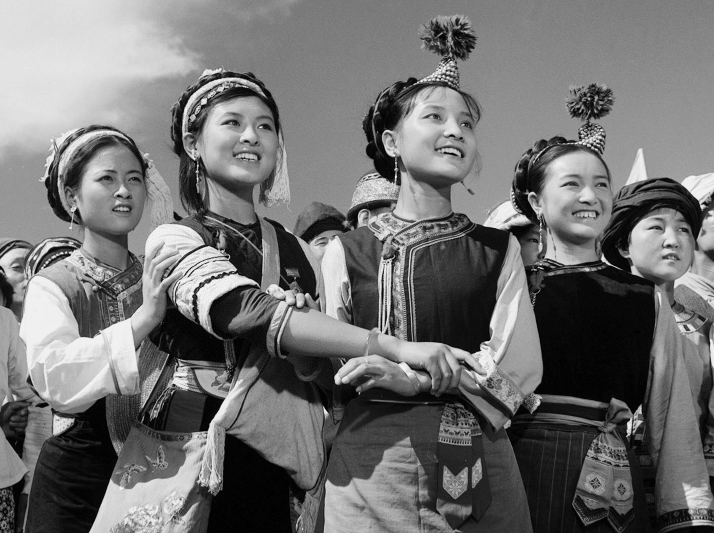|
||||||||||
| Home Nation World Business Opinion Lifestyle ChinAfrica Multimedia Columnists Documents Special Reports |
|
||||||||||
| Home Nation World Business Opinion Lifestyle ChinAfrica Multimedia Columnists Documents Special Reports |
| ChinAfrica |
| The Reel Story |
| Chinese film industry's growth over seven decades |
| By Tang Yuankai | VOL.11 December ·2019-12-13 |

An exhibition of posters of domestic films produced over the past 70 years is held in Qingdao, east China's Shandong Province, on August 25, in celebration of the 70th anniversary of the founding of the People's Republic of China (XINHUA)
When President Xi Jinping conferred national medals and honorary titles on 42 people on September 29 during the countdown to the 70th anniversary of the founding of the People's Republic of China (PRC), one of them was from the film industry.
Qin Yi, who was awarded the title of People's Artist, has another distinction. At 97, she is yet to hang up her acting boots. Last year, she played an inspirational woman in the film Goddesses in the Flames of War, director Jiang Ping's commemoration of history with the story of a group of heroic Chinese women who defended their villages against Japanese invaders during the Chinese People's War of Resistance Against Japanese Aggression (1931-45).
Though dubbed the Oriental Venus by some Western media because of her striking appearance, Qin has continued to move generations of theatergoers with her portrayal of ordinary women.
Inspiration and popularity
The patriotic films bringing to the fore tales of courage, dedication and sacrifice during times of adversity have inspired generations and continue to do so. For instance, Children of Troubled Times, a 1935 film, gave courage to people to fight against the Japanese invasion. Directed by Xu Xingzhi, it is about the transformation of an intellectual who wavers between choosing his country and a Western lifestyle. But after the death of his friend, who had joined the Chinese resistance movement to fight the Japanese, he too joins the movement.
The first feature film made after the founding of the PRC was Bridge directed by Wang Bin, in which the working class became the protagonists in a Chinese film for the first time. To prepare for the film, Wang asked the actors to seek out similar figures they were to portray among ordinary people and learn about them and experience their lives before the shooting started. This kind of acting method has since become a tradition of Chinese films and artists. With Bridge, the aspirations, ability and heroism of the Chinese people became themes for the big screen, marking the adoption of realism in Chinese films.
In 1950, Wang co-directed The White-Haired Girl with Shui Hua. Based on a namesake opera that premiered in 1945, the film is about a 17-year-old girl named Xi'er, who is forced to become the indentured servant of wicked landlord Huang Shiren as payment for her father's debts. Xi'er's traumatic life makes her hair turn white. She is rescued after the Communist Party of China (CPC) launches a people's fight against the oppression of landlords and Huang is killed.
In 1951, the film was awarded the Special Jury Prize at the Sixth Karlovy Vary International Film Festival, the largest film festival in Czechoslovakia, the first time a Chinese film had won an international award after the founding of the PRC.
Since the founding of the PRC, the Central Government began to work to bring films to more people, and film projectionists were hired to run mobile cinemas. In the following 10 years, the number of rural mobile cinemas increased from none to over 10,000. Besides, many films were made on subjects of mass appeal for the benefit of farmers, workers and soldiers.
In 1956, Chairman Mao Zedong proposed to boost the development of socialist culture. In the two years that followed, the number of films produced soared, with 97 feature films made, and the genre of films diversified. In 1957, 1.7 billion film tickets were sold. From 1949 to 1966, a number of excellent movies hit the screen.

A still from Five Golden Flowers, a musical film of 1959 (XINHUA)
New momentum
In December 1978, the reform and opening-up policy was adopted in China, marking the beginning of a momentous change in China. It ignited filmmakers' enthusiasm.
In 1986, film director Xie Jin's signature work Furong Zhen, or Hibiscus Town, won him the Hundred Flowers Award for the best feature film, the fifth time that Xie won the award.
Based on a novel by the same name written by Gu Hua, the melodrama follows the life and travails of a young woman who lives through the turmoil of the "cultural revolution" (1966-76). The film had a box-office earning of over 100 million yuan ($29 million, at then exchange rate). It meant 500 million to 1 billion tickets were sold for the film, with the ticket price at only 0.1-0.2 yuan ($0.029-$0.058, at then exchange rate). In the 1980s, the film magazine Popular Movies had a circulation of over 9 million copies per month, which indicated people's love for films.
An increasing number of Chinese filmmakers began to win prizes at international film festivals. Chen Kaige's Farewell My Concubine, telling the story of two men who met as apprentices in a Peking Opera troupe and whose lives were linked by vicissitudes for over 50 years, claimed the Palme d'Or at the prestigious Cannes Film Festival in 1993. The movie was selected for the U.S. Academy Award as the best foreign film a year later.
The foreign factor
In 1994, a quota system was introduced for foreign movies screened in China. Under it, 20 foreign films were allowed to be screened in China every year, with foreign producers allowed 13 percent of the film's box-office revenue. In 2012, the quota was increased to 35 films and foreign producers could claim 25 percent of the revenue.
The introduction of more foreign films not only galvanized the sluggish Chinese cinema but also enabled domestic filmmakers to learn about the standards and operational model of foreign films and face competition.
In 2002, Zhang Yimou tried his hand at blockbusters. The period drama Hero was released in October 2002. It had an investment of 240 million yuan ($30 million at then exchange rate), 100 times the investment of an average Chinese film at the time. It was a great commercial success, with its box-office takings surpassing 100 million yuan ($12.5 million at then exchange rate) within one week of release and total earnings that year accounting for a quarter of China's entire box-office revenue that year.
For a long time, a film with a box-office income of 20-30 million yuan ($2.4-3.6 million at then exchange rate) was considered successful. Now a film with a box-office taking of over 100 million yuan ($14 million) is no longer a rarity. International cooperation in filmmaking has also become more frequent. An increasing number of countries have film co-production agreements with China. Co-produced films are treated as domestic productions and are therefore not subject to the quota system, which can bring both sides better revenue. Chinese film producers are also starting to make films abroad through cooperation with overseas institutions in capital, talent, technology and market, expanding the horizon of domestic films.
(Comments to zanjifang@chinafrica.cn)
| About Us | Contact Us | Advertise with Us | Subscribe |
| Copyright Beijing Review All rights reserved 京ICP备08005356号-5 京公网安备110102005860号 |